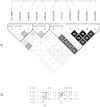Associations of Plasma FGF2 Levels and Polymorphisms in the FGF2 Gene with Obesity Phenotypes in Han Chinese Population
- PMID: 26879180
- PMCID: PMC4754629
- DOI: 10.1038/srep19868
Associations of Plasma FGF2 Levels and Polymorphisms in the FGF2 Gene with Obesity Phenotypes in Han Chinese Population
Abstract
Obesity is highly heritable, but the specific genes influencing obesity related traits are largely unknown. Fibroblast growth factor 2 (FGF2) could influence adipocyte differentiation. However, the association of FGF2 polymorphisms and obesity remains unclear. This study aimed to investigate the associations of both the plasma FGF2 levels and SNPs in FGF2 gene with obesity phenotypes in Han Chinese populations. Plasma FGF2 levels were measured and subjected to association analyses in 62 subjects. Eleven SNPs in FGF2 were genotyped and tested for associations in a discovery sample of 1,300 subjects. SNPs significantly associated with obesity were subjected to replication in another independent sample of 1,035 subjects. We found that plasma FGF2 levels were positively correlated with fat mass (P = 0.010). Association analyses in the discovery sample identified three SNPs (rs1449683, rs167428, rs308442) significantly associated with fat mass after multiple testing adjustments (P < 0.0045). Subsequent replication study successfully validated one SNP (rs167428) associated with fat mass (P(combine) = 3.46 × 10(-5)). eQTL analyses revealed that SNPs associated with obesity also affected FGF2 expression. Our findings suggested that high plasma FGF2 level correlated with increased risk of obesity, and FGF2 gene polymorphisms could affect individual variances of obesity in Han Chinese population.
Figures


References
-
- Kopelman P. G. Obesity as a medical problem. Nature 404, 635–43 (2000). - PubMed
-
- Consultation W. H. O. E. Appropriate body-mass index for Asian populations and its implications for policy and intervention strategies. Lancet 363, 157–63 (2004). - PubMed
-
- Stunkard A. J., Foch T. T. & Hrubec Z. A twin study of human obesity. JAMA 256, 51–4 (1986). - PubMed
-
- Maes H. H., Neale M. C. & Eaves L. J. Genetic and environmental factors in relative body weight and human adiposity. Behav Genet 27, 325–51 (1997). - PubMed
-
- Loos R. J. & Bouchard C. FTO: the first gene contributing to common forms of human obesity. Obes Rev 9, 246–50 (2008). - PubMed
Publication types
MeSH terms
Substances
LinkOut - more resources
Full Text Sources
Other Literature Sources
Medical

